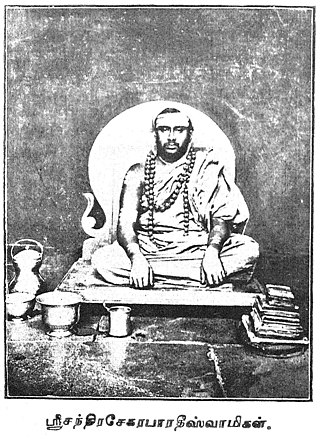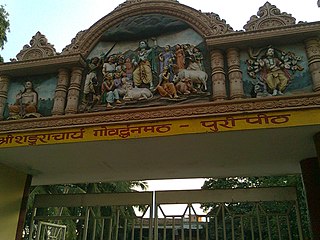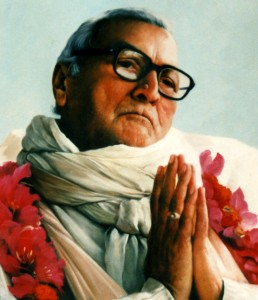| Part of a series on | |
| Hindu philosophy | |
|---|---|
 | |
| Orthodox | |
| Heterodox | |
This is a list of teachers of Vedanta, a Hindu philosophical system.
| Part of a series on | |
| Hindu philosophy | |
|---|---|
 | |
| Orthodox | |
| Heterodox | |
This is a list of teachers of Vedanta, a Hindu philosophical system.

Swami Dayananda Saraswati was a renunciate monk of the Hindu Saraswati order of sannyasa. He was also known as Pujya Swamiji and was a traditional teacher of Advaita Vedanta. He was the founder of the Arsha Vidya Gurukulams in Pennsylvania, USA; Rishikesh, Uttarakhand and Coimbatore Tamil Nadu, India. He was also the spiritual Guru of Prime Minister Narendra Modi. He was awarded the Padma Bhushan,, for his service to the nation in the field of spirituality in 2016.

Swami Sivananda Saraswati, also called Swami Sivananda, was a yoga guru, a Hindu spiritual teacher, and a proponent of Vedanta. Sivananda was born in Pattamadai, in the Tirunelveli district of modern Tamil Nadu, and was named Kuppuswami. He studied medicine and served in British Malaya as a physician for several years before taking up monasticism.

The Vishnu Sahasranama is a Sanskrit hymn containing a list of the 1,000 names of Vishnu, one of the main deities in Hinduism and the Supreme God in Vaishnavism. It is one of the most sacred and popular stotras in Hinduism. The most popular version of the Vishnu Sahasranama is featured in the Anushasana Parva of the epic Mahabharata. Other versions exist in the Padma Purana, the Skanda Purana, and the Garuda Purana. There is also a Sikh version of the Vishnu Sahasranama found in the work Sundar Gutka.

Shankaracharya is a religious title used by the heads of amnaya monasteries called mathas in the Advaita Vedanta tradition of Hinduism. The title derives from Adi Shankara; teachers from the successive line of teachers retrospectively dated back to him are known as Shankaracharyas.

The Gaudiya Math is a Gaudiya Vaishnava matha formed on 6 September 1920, about 30 months after Bhaktisiddhanta Sarasvati took sannyasa, the renounced order of life. On 7 March 1918, the same day he took sannyasa, he established the Sri Chaitanya Math in Mayapura in West Bengal, later recognised as the parent body of all the Gaudiya Math branches. Its purpose was to spread Gaudiya Vaishnavism, the philosophy of the medieval Vaisnava saint Chaitanya Mahaprabhu, through preaching and publishing.
Jagadguru, literally meaning "guru of the universe", is a title used in Sanātana Dharma. Traditionally, it has been bestowed upon or used for ācāryas belonging to the Vedānta school who have written Sanskrit commentaries on the Prasthānatrayī – the Brahma sūtras, the Bhagavad-gītā and the principal Upaniṣads. Historically, jagadgurus have established a lineage and an institution to spread dharma which has been based in Varanasi, the centre of Sanskrit study.

Swami Chandrasekhara Bharati was the Jagadguru Sankaracarya of Sringeri Sharada Peetham in 1912–1954. He was one of the known spiritual figures in Hinduism during the 20th century. He is a Jivanmukta.

The Daśanāmi Sampradaya, also known as the Order of Swamis, is a Hindu monastic tradition of "single-staff renunciation" Ēkadandis were already known during what is sometimes referred to as "Golden Age of Hinduism". According to hagiographies composed in the 14th-17th century, the Daśanāmi Sampradaya was established by Vedic scholar and teacher Adi Shankaracharya, organizing a section of the Ekadandi monks under an umbrella grouping of ten names and the four cardinal mathas of the Advaita Vedanta tradition. However, the association of the Dasanāmis with the Shankara maṭhas remained nominal.

The Vivekachudamani is a philosophical treatise within the Advaita Vedanta tradition of Hinduism, traditionally attributed to the Vedāntic philosopher Adi Shankara, though this attribution has been questioned and mostly rejected by scholarship. It is in the form of a poem in the Shardula Vikridita metre.

Purvamnaya Sri Govardhana Pitham or Govardhan Math is one amongst the four cardinal pithams established by the philosopher-saint Adi Shankara to preserve and propagate Hinduism and Advaita Vedanta, the doctrine of non-dualism. Located in Puri in Odisha, India, it is the Eastern Āmnāya Pītham amongst the four pithams, with the others being the Sringeri Śārada Pīṭhaṃ (Karnataka) in the South, Dvārakā Śāradā Pītham (Gujarat) in the West, Badari Jyotirmaṭha Pīṭhaṃ (Uttarakhand) in the North .It is associated with the Jagannath temple. Their Vedantic mantra or Mahavakya is Prajñānam brahma and as per the tradition initiated by Adi Shankara it holds authority over the Rigveda. The head of the matha is called Shankarayacharya, the title derives from Adi Shankara.

Sri Sharadamba Temple is a famous Hindu temple dedicated to goddess Sharadamba in the holy town of Sringeri in Karnataka, India. It is located next to the Tunga river.

Bhakti Prajnan Keshava, addressed by the honorific Mahārāja, was a Gaudiya Vaishnava guru, disciple of Bhaktisiddhanta Sarasvati and the founder-acharya of the religious organisation "Sri Gaudiya Vedanta Samiti", formed in Calcutta in 1940, and its headquarters, monastery Sri Devananda Gaudiya Math in Nabadwip.

Chidananda Saraswati was president of the Divine Life Society, Rishikesh, India. He is well known in India as a yogi and spiritual leader. He succeeded as president of the Divine Life Society in 1963, after the death of his predecessor, Sivananda Saraswati, who founded the Society.

Shri Gaudapadacharya Math, also known as Kavaḷē maṭha, located in Kavale, Ponda, Goa, is the oldest matha of the Smarthan Saraswat Brahman Samaj. It was founded by Gauḍapāda around 740 AD, whose student was Govinda Bhagavatpada, the guru of Adi Shankara, a highly influential figure in Hinduism. There is also a belief that Gauḍapāda himself established the Shri Gaudapadacharya matha when he lived in Gomantak (Goa). Thus, the matha came to be known as Shri Saunstan Gaudapadacharya matha. Unlike other mathas, Shri Gaudapadacharya matha is not a polemical center established to influence the faith of all Hindus, its jurisdiction is limited to only Dakshinatya Saraswat Brahmins. The Peetadhipathi "head monk" is Śrī Gauḍapadācārya. Smartist Goud Saraswat Brahman Samaj and Rajapur Saraswat Brahmin are its main disciples.

Sri Devananda Gaudiya Math is situated at Teghori Pada in Nabadwip dham of district Nadia in the West Bengal state of India, and is a matha and prominent holy place of the Gaudiya Vaishnavas, as well the headquarters of the Sri Gaudiya Vedanta Samiti. It is located in the middle of the place earlier known as Koladvipa. Math has been continuing as a famous religious spot thronged by thousands of devotees every year.

The Advaita Guru-Paramparā is the traditional lineage (parampara) of divine, Vedic and historical teachers of Advaita Vedanta. It begins with the Daiva-paramparā, the gods; followed by the Ṛṣi-paramparā, the Vedic seers; and then the Mānava-paramparā, with the historical teachers Gaudapada and Adi Shankara, and four of Shankara's pupils. Of the five contemporary acharyas, the heads of the five Advaita mathas, four acharyas trace their lineage to those four pupils and one to Adi Shankara himself.

Bijoy Krishna Goswami, also known by the honorific Gosaiji, was a Hindu social reformer and religious figure in India during the British period.

Uttarāmnāya Śrī Jyotish Pītham or JyotirMath is one amongst the four cardinal pīthams established by the Ādi Śaṅkara 1300 years ago to preserve Hinduism and Advaita Vedānta, the doctrine of non-dualism. Located in the city of Joshimath, Chamoli district, Uttarakhand, India, it is the uttarāmnāya matha or Northern Āmnāya Pītham, amongst the four Chaturamnay Peethams - Kalady Kerala, birthplace of Adi Shankara with the others being the Sringeri Śārada Pīṭhaṃ (Karnataka) in the South, Dvārakā Śāradā Pītham in the West and Purī Govardhanmaṭha Pīṭhaṃ in the east. Its appointees bear the title of Shankaracharya. It is the headquarters of Giri, Parvata & Sagara sects of the Dasnami Sampradaya. Their Vedantic mantra or Mahavakya is Ayamātmānam brahma and as per the tradition initiated by Adi Shankara it holds authority over Atharva Veda. The head of the matha is called Shankaracharya, the title derives from Adi Shankara.

Bhakti Rakshak Sridhar was an Indian guru, writer, sannyasi and spiritual leader in the Gaudiya Vaishnava tradition of Chaitanya Mahaprabhu, founder-president-acharya of the Sri Chaitanya Saraswat Math.